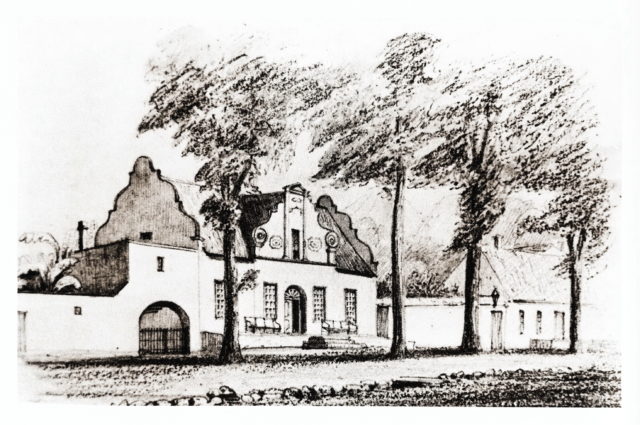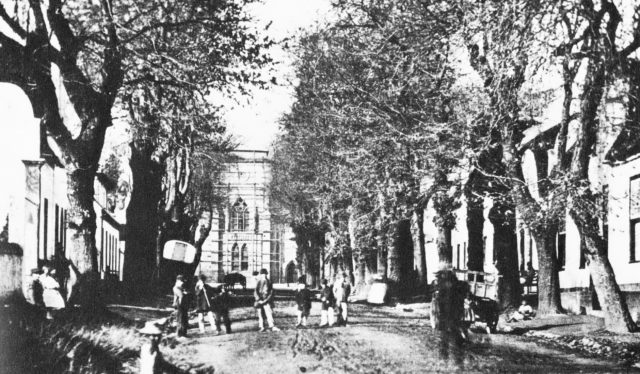Did you know that when you sit in the Oude Werf Restaurant, enjoying your delicious meal, you are sitting in the exact spot where the congregation of South Africa’s first church worshipped? The Church Street hotel has also been in operation longer than any other in South Africa.
Built between 1686 and 1687, the thatch-roofed building of “22 x 40 Rhenish feet” and its bell tower are visible in the earliest known sketch of Stellenbosch from 1710, before the Church and much of Stellenbosch was destroyed by fire.
Though attempts were made to rebuild it, a new site was chosen at the top of present-day Church Street, with much of the surviving building material absorbed into a new church begun in 1717. The “old churchyard” (de Oude Werf ) stood vacant for some 70 years, until the landdrost Daniel van Rijneveld divided the site into lots for sale – an act of “religious desecration” many believed doomed him to clatter through the old yard on horseback for eternity as Oude Werf’s first legendary ghost.
 Oude Werf’s early history was forgotten over time. In 1783, on the deconsecrated ground, owner JB Hoffman is credited with the building of an elegant Cape Dutch gabled house in 1802. It opened its doors to guests as an inn and Mr Wolfrom, the proprietor, ensured “amiable lodging for 3 Rix Dollars a day”, including local wine and food.
Oude Werf’s early history was forgotten over time. In 1783, on the deconsecrated ground, owner JB Hoffman is credited with the building of an elegant Cape Dutch gabled house in 1802. It opened its doors to guests as an inn and Mr Wolfrom, the proprietor, ensured “amiable lodging for 3 Rix Dollars a day”, including local wine and food.
“This house being crowded, during the summer season, with visitors from the Cape, may with propriety be called the fashionable resort … Here may be procured the finest fruits in the colony; our table groaned under a load of excellent peaches, apricots, and grapes… [and] we were well provided with excellent Roman fish… I could be contented to pass the remainder of my days there,” wrote a British officer in Gleanings in Africa, published in 1805.
Later guests, like Governor Sir George Grey, accompanying Prince Albert on his travels in1860, also praised the “generous victuals” dispensed by Wouter Wium and his wife Tant Betjie, who remains one of Oude Werf’s most colourful figures.
 Karl Otto Hager was another guest. He would become South Africa’s most prolific church architect but in 1841, still a poor painter, he gazed from the windows of the inn at the beautiful Cornelia and hatched a romantic plan. Convincing her father to be the subject of a portrait, the usually speedy Hager took no less than seven long sittings to capture the likeness of the man and eventually, the hand of Cornelia, who became his wife.
Karl Otto Hager was another guest. He would become South Africa’s most prolific church architect but in 1841, still a poor painter, he gazed from the windows of the inn at the beautiful Cornelia and hatched a romantic plan. Convincing her father to be the subject of a portrait, the usually speedy Hager took no less than seven long sittings to capture the likeness of the man and eventually, the hand of Cornelia, who became his wife.
Sometime after 1889, a second storey was added in Georgian style and the hotel (which had been known variously as Wium’s Inn, Arcadia and Harmonia) functioned as a “parlour boarding house” for some of the first female students at the fledging university – the origin of Stellenbosch’s first women’s sorority house, Harmonie.
Gerhard Lubbe bought the Hotel in 1972 and began its extension and restoration, which in 1981 saw archaeological excavations reveal the church’s granite foundation, pillars that had supported its roof, the likely position of the ‘preekstoel’ (pulpit) and early (disinterred) graves – some elements of which are still visible beneath the kitchen and in the ground-floor room wing.
Today, Oude Werf Hotel is owned by the Petousis hotelier family, whose Albertyn ancestors were some of the original church’s first congregants. The seamless integration of contemporary renovations and extensions in 2015 was so sympathetically accomplished that it won architects Revel Fox and Partners an architectural award.
Now, a luxury hotel with all the comforts of 21st-century amenities, Oude Werf on Church Street still celebrates its 300 year history as a national heritage site and as South Africa’s oldest continuously-running hotel.
